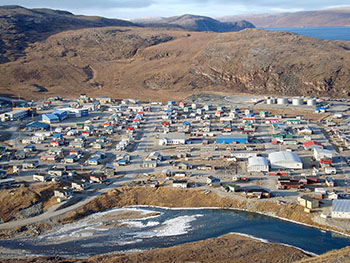Climate change may force relocation of Salluit
Nunavik village left with no room to grow

Between a rock and a hard place: the Hudson Strait community of Salluit faces tough decisions about a future complicated by warming land and air temperatures. (FILE PHOTO)
People in Salluit may someday see their community — or at least some of it — moved to a new location.
That’s because much of the land available for development near Salluit may undergo landslides or become unstable if warming continues at the current rate over the next 20 years.
The soil temperature in Salluit has increased by 1 C over the past 10 years, while average air temperatures have risen by at least 3.3 C since 1990.
If these trends continue, the clay-rich soils under the older part of town, which are sandwiched between layers of ice, could turn to mud and cause buildings to settle by up to three feet, causing them to buckle and collapse.
As climate change threatens to melt the land in and around this growing Hudson Strait community of 1,200, a committee with members from Quebec, the Kativik Regional Government and Salluit continues to look at solutions, including moving all or part of the community to a new location.
“Unthinkable” is how Adamie Papigatuk, a regional councillor with the KRG, called the possibility of his community’s relocation a year ago.
But the way the future looks now, with at least 60 new social housing units needed in Salluit over the next 20 years, there’s no room left to build safely at the community’s current site.
In the future, Salluit could see landslides or slippages similar to those that destabilized a neighbourhood of 20 new houses in 1998. Moving these houses to safer locations cost Quebec hundreds of thousands of dollars.
Salluit’s fire station had to be taken down in 2006 and moved after its foundation cracked.
Part of the challenge facing the community’s growth is a lack of space. Salluit sits on a steep-sided valley bottom that runs along the coast.
The valley walls protect the community from high winds, but also restrict the land available for growth.
Some areas of solid ground remain available for building, but they are fairly steep, says a recent Natural Resources Canada climate change study on Salluit.
Land to the east of Salluit lies on soil that is lower in ice content than that in town, but this area could still become unstable if higher temperatures affect the underlying permafrost, that is, soil or rock which has remained below freezing for at least two consecutive years.
All this instability spells trouble and explains why the committee was empowered in 2007 to make a two-year intensive study on the future of Salluit.
The committee wants to manage the short-term development of Salluit, prevent more damage, monitor the permafrost, and make a plan for the community’s future, which is technically and financially feasible.
One option under consideration may involve the relocation of the community, either wholly or in part.
A nearby place that could be developed into a new satellite neighbourhood is a 300,000-square metre rocky promontory at Tikiraatsiaq, about two km west of Salluit.
Studies show Tikiraatsiaq has ample space for the community’s future growth, easy access to the coast and there’s already a partial road in place.
But Tikitraatsiaq’s disadvantages include winter winds up to 90 km an hour, many unexcavated archaeological remains and the presence of possible pollution from a river that carries Salluit’s wastewater down to the sea.
Another possible location is the Kiggaluk valley, nine km east of Salluit, which is large enough to house a community the size of the existing town.
But a major obstacle to moving there would be the high cost of building a road from the old community to the new because it would have to traverse rivers and rocky outcrops.
Another option could be adding on to the present community of Salluit, by filling out from the shore.
But this option would carry its own environmental consequences, research studies suggest.
Meanwhile, the Quebec transport department is looking at ways to repair the existing permafrost damage and how to avoid more problems on Salluit’s airport access roads and runway, which are already showing signs of damage.
A team led Université Laval’s Centre des etudes nordiques will continue its monitoring activities through 2009
Related information:
- Toronto Star, July 10: Canada’s shameful inaction on climate change, by Mary Simon





(0) Comments